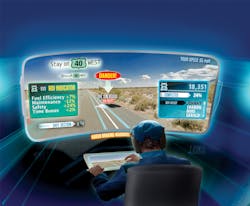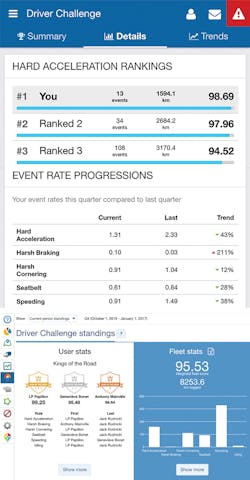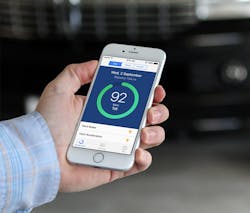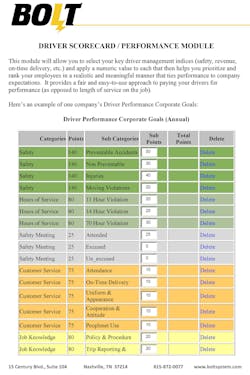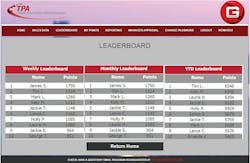Year-after-year, Southeastern-based carrier G&P Trucking brought home the gold for safety in the competitions it entered. More recently, however, the company noticed an increase in accidents, and though it still won trophies for safety, they weren’t first place. That’s when safety director John Billingsley stepped in.
Unsure of what was causing the uptick in the frequency of accidents, in July 2014, Billingsley turned to SmartDrive’s video safety program. He initially thought data from the in-cab videos would help exonerate fleet drivers when an accident occurred. But the data from the video ended up telling a different story.
“We wanted exoneration from accidents that weren’t our fault, and we knew our drivers were well-educated and well-trained already,” Billingsley tells Fleet Owner. “But we realized that wasn’t really accurate.”
That’s when G&P decided to gamify its operations. After testing different methods with the company’s driver improvement coach and studying the data coming in from the video system, G&P began leveraging that data and video software to use competition-based incentives to improve safety.
Gamification uses game mechanics and dynamics to drive engagement and key performance indicators, or KPIs, in a non-game context. It is more or less about using natural instinct and reward incentives to drive or change current behavior.
Working on the notion that everyone is programmed to win and used to playing games, Billingsley and his team began discussing ways to gamify through coaching, driver scoring and rewards programs.
A look inside the Driver Challenge app
“We can talk about scoring, which everyone can relate to,” Billingsley explains. “That just made it a much easier conversation. Then you could also tell people, without sharing a bunch of details, what other [drivers’] scores are. Everyone can learn how the system works.”
G&P uses a point-reduction system, so when a driver saves on fuel, drives the right speed or avoids harsh braking and swerving, then points are deducted from that driver’s score. G&P posts drivers’ scores on a leaderboard, and the driver with the lowest score has “achieved excellence.” As long as that driver maintains a score of excellence, his or her coaches don’t coach any further, Billingsley says. This way, coaches end up spending time helping drivers on the wrong side of the bell curve improve.
“We know exactly who we need to talk to and what we need to talk about,” Billingsley explains. “And that works well for us. It gives us the ability to attentively talk to drivers and look up a score. We can talk to them and coach them right there on the spot to help them improve their score. We just really talk about being able to get them into the next level eligible for award of some sort.”
G&P gives cash rewards to its drivers who come out on top. The carrier awards a total of $1,000 a month, or $250 a week to the top driver for that week.
Two years in, G&P reports it has seen major shifts in driver improvement and what Billingsley calls a “huge” reduction of accident costs and frequency. The fleet has also seen a reduction in accident-causing behaviors, such as close following distance, hard braking, and lane departure.
“We have candid conversations that no one would ever use any video for the purpose of anything other than being a safer driver,” he says. “We’re trying to push that scoring mechanism as a way to improve longevity. In lowering our score, we have accident forgiveness. If a driver has an accident that in the past would have cost them their position and if they have a low score, they are more likely to stay and keep their job.”
It’s human nature
The objective of gamification is to drive better employee performance while using real-time feedback and goals. In trucking that could mean improving fuel efficiency and return on investment; improving safety, which could result in fewer accidents and overall maintenance costs; and overall improved productivity throughout the fleet and workplace.
Jason Palmer, SmartDrive’s president, notes the focus of gamifying safety and operations for fleets is incentivizing drivers. “We see a lot of the fleets we work with recognize the top 10 or 20% of drivers, and they will publish that in the driver lounge and recognize that driver performance,” he says. “It helps to foster the positive aspects of the program.”
Another provider that offers a similar scorecard concept is Telogis, which provides a way for fleets to leverage gamification through its Telogis Coach app.
“When fleets look to Telogis to help them gamify their operations, most of them seek improvements in safety, productivity, and fuel efficiency.”
- Mark Wallin, Telogis vice president of product management
“The moment you take a score and put it in front of a driver, it motivates them in amazing ways,” Mark Wallin, vice president of product management, says. “When you put that same score amongst their peer group, you get really amazing benefits.” He adds companies are creative in terms of how they’ve rolled out the Coach app in office common areas, and incentives and rewards are more commonly added to fleet safety programs.
And rewards can be as simple as a cup of coffee or allowing top-scoring drivers to use the newest, most advanced trucks and equipment. “The companies that succeed are the ones that are leveraging the benefits of being on the top,” Wallin adds. “With more people on the top, you’re making changes faster and getting results faster.”
When fleets look to Telogis to help them gamify their operations, most of them seek improvements in safety, productivity, and fuel efficiency, Wallin notes. Right away, some of the big benefits fleets might see when gamifying their operations are accelerating ROI to safety improvements, fuel usage, and productivity among workers.
“I think the gamification really helps [drivers] feel good about what they’re doing,” Wallin says. “Almost every person wants to be good at what they do. Sometimes they don’t understand what good means, and the app helps them with that.
“It’s about empowering them to be the best driver and the best worker,” he adds. “That’s really important when you look at millennials and the next generation of drivers.”
Jerry and Gayle Robertson also brought their own version of a driver scorecard to the market. The two have backgrounds in supply chain management and technology, and in 2000, they moved from Silicon Valley to Nashville. They started BOLT System, a fleet management and trucking dispatch software provider, while simultaneously operating an over-the-road trucking company, which they sold in 2006. A feature of BOLT’s software is its driver scorecards, which fleet managers can use to track different aspects of their drivers’ behaviors and distribute awards accordingly.
“Fleets do publish [drivers’] results on a monthly basis and post them on a board,” Gayle adds. “People don’t like to be at the bottom.”
Canadian-based carrier Transport Grayson began gamifying its operations in December 2016 to save on fuel costs, track its fleet, and improve driver management. It uses the d2go Driver Challenge app, available on the Geotab Marketplace, and since using the app, the company notes it has seen an immediate reduction in fuel usage and idling times.
“While Geotab gives us information on the truck (trips, fuel usage, faults, etc.), the Driver Challenge highlights driving habits like harsh braking and cornering, idling, seat belt use, and more,” explains Bertrand Grégoire, Transport Grayson president.
Grégoire, along with Jonathan Grégoire, who is vice president of the company, founded Transport Grayson in April 2013. Operations began in August 2013 with 20 new Kenworth T680 trucks and about 50 Utility and Manac 53-ft. trailers. Today, the fleet has over 100 semi-trucks and about 300 trailers.
Transport Grayson specializes in freight transportation, including specialty fleets such as hazmat operations, across Canada and the U.S. They also offer temperature-controlled transportation with heated and refrigerated trailers.
At Transport Grayson, drivers are rewarded for good behavior and responsible idling management with a per-mile bonus. Conversely, after noticing an incident, fleet managers work with the drivers to alert them of risky behavior. So, in the case of excessive idling, a driver will receive up to four warnings before corrective action is taken, Grégoire explains.
“In cases that pose a serious health and safety risk, the repercussions may be more immediate to avoid any risks to our drivers’ safety,” he adds. “We feel there are big savings to be made on fuel and maintenance. It raises drivers’ awareness of the quality of their driving and encourages safer habits.”
Scott Sutarik, business development and OEM sales manager at Geotab, says the reason gamification works is that it’s natural for people to want to compete with each other.
“When you see a dashboard up there and there are 100 drivers and you’re number 79, human nature is you want to get better,” Sutarik explains. “That’s really the goal of what these applications are trying to achieve—to get that competitive spirit up and going while saving the company on fuel use, wear and tear on the vehicle, productivity, and safety as well.”
Louis-Philippe Papillion is the vice president of d2go and creator of the app, which started a year ago as a basic driver dashboard to show drivers how they’re doing. Along the way, it turned into a gamification platform where drivers could see how they are performing in comparison to their peers.
“I think it’s always been a challenge to coach drivers because they’re alone and you don’t see what they’re doing,” Papillion says. “It’s pretty hard to reward good drivers and address worse drivers; it’s not easy to identify them. Those are some of the tools we’re applying now with Geotab. We’re giving them data they didn’t have access to years ago.”
And like Telogis suggests, Sutarik notes that gamification could also be used as a tool when it comes to retaining drivers and recruiting the next generation of drivers.
“Fleets that are putting technology like this into their [operations] are more innovative,” Sutarik says. “For drivers that want the latest technologies, the ability for a fleet to give tools like this to their drivers is very much the way the industry is going. Drivers flip from one carrier to another. Anything you can do to show that you’re committed to them is a real benefit.”
Not ‘fun and games’
Ray Wezner, who has been the chief operating officer of TPA (Trade Promotion Administration) for more than 20 years, says he has been practicing gamification tactics before the term was invented, which he says was about seven or eight years ago.
“When [businesses] really coined that phrase, they were looking at game-based education,” Wezner explains. “They were trying to teach people information using games. That kind of grew into competition and leaderboards, and on and on.”
“We were using leaderboards and publishing them through our websites—12 to 15 years ago—in the days before smartphones,” Wezner adds.
This year, Wezner teamed up with Marty Hetherington to bring their spin on gamification to truck fleets. Hetherington has a background in trucking and is the founder of Skinny Marketing.
Gamivation.com is a points-based platform that focuses on performance improvement through a combination of incentives. Like other gamification platforms, Gamivation.com, too, incorporates rewards based on performance.
But one thing Wezner says is critical when putting together a program is making sure managers are always involved. “You have to make sure you’re following up with people,” he notes. “That’s why manager participation is so important.
“There are company cultures out there that as soon as you say ‘gamification,’ they say that’s not us,” Wezner adds. “We have to take this seriously. The fact of the matter is, it’s not fun and games.”
And that’s a mantra G&P has taken to heart. Because making the move to gamify fleet operations is so serious, when G&P decided to roll out its plan, Billingsley stresses how important it was to be open and honest with all drivers and employees and to have regular training meetings. When it comes to recruiting new drivers, Billingsley says G&P is up front about its use of in-cab cameras, as well as how the carrier has leveraged gamification to reduce crashes.
“It’s a bit controversial. We understand that, but I think we found an effective way to talk about it prior to it being installed,” Billingsley adds.
About the Author

Cristina Commendatore
Cristina Commendatore is a past FleetOwner editor-in-chief. She wrote for the publication from 2015 to 2023.
